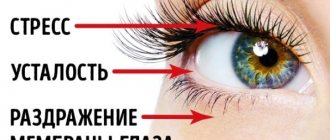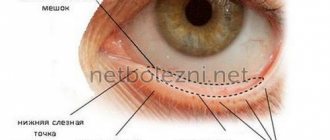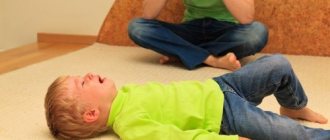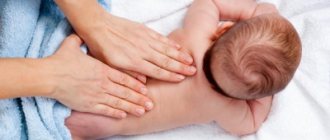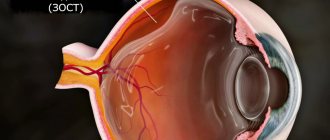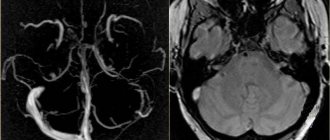In early childhood, neuropsychiatric disorders such as tics are quite common.
The scientific name is tic hyperkinesis. Parents immediately notice changes in the baby’s behavior. Uncontrolled movements of certain parts of the body or certain muscles in a child cannot but become a cause for concern and questions arise:
- Where did the disease come from?
- Could it have been prevented?
- What to do?
- How to treat?
This list can go on for a long time. One thing is clear - there is certainly cause for concern. And the first thing you need to do is find out as much information as possible about this neurological disorder.
So what are nervous tics in children and what is their danger?
General concept of ticks
This is the most popular pathology of the children's nervous system at an early age. It is simply impossible not to visually notice the manifestation of a tic, although some parents manage to go for weeks or even months without seeing any oddities in their child’s behavior.
Tics are involuntary, stereotypically repetitive, sudden or jerky movements that are the result of spontaneous contraction of individual muscles or groups of muscles.
At the initial stage of development of the disorder, attacks occur quite rarely, and repetitive movements do not cause much concern or problems. The child can even restrain or control them. However, attempts to control the tic cause him:
- internal discomfort;
- feeling of anxiety;
- mental stress.
When control over oneself weakens, tic manifestations occur, and the baby immediately receives obvious relief.
Nervous tics in children are usually detected between the ages of two and fifteen years. In the period of 6–8 years, tic hyperkinesis most often develops, while at 14–15, in approximately half of the cases it disappears spontaneously.
Fun fact: Boys are five times more likely to have the disorder than girls. From a scientific point of view, this is explained by the more stable psyche of female representatives.
Eye twitching due to fatigue
Physical and emotional fatigue seriously affects your health. Stressful work and regular lack of sleep can lead to involuntary contractions of the eye muscles. Children today are constantly faced with a colossal load on the visual system. As a rule, they are fond of computer games and gadgets, like to read books and comics in poor lighting, and also watch cartoons for a long time in front of the TV. During all these actions, blinking occurs rarely, as a result of which the nerves and eye muscles begin to be subjected to significant stress.
Types of nervous tics in children
Each child has his own individuality, and therefore nervous tics that arise for one reason or another are different.
Tic manifestations generally have two types:
- Motor (motor). They are detected by spasms of individual muscles, their groups or movement of limbs and other parts of the body.
- Voice (vocal). They can be recognized in the form of frequently repeated individual sounds, syllables, exclamations, words and even phrases.
Both groups are divided into simple and complex tics. Everything is clear here. A simple form - one short movement or sound, a complex one - several muscle groups are involved, if there are vocal disorders, progress is also observed in them.
Main manifestations
Localization of tic movements most often occurs in the facial or neck muscles. Over time, they can spread from top to bottom. The most common examples of simple childhood motor tics are:
- frowning;
- blinking;
- squinting;
- moving the wings of the nose;
- drawing in air through the nose;
- twitching of the corner of the mouth;
- turning or tilting the head;
- shrug;
- flinching;
- twitching of limbs;
- flexion or extension of fingers;
- snapping fingers.
Vocal tics are manifested by coughing, throat sounds, sniffling, spoken syllables or exclamations. This is a meaningless sound that interferes with speech and gives the impression of stuttering or stuttering. If no measures are taken to eliminate them, the situation will only get worse. Tic movements also progress and reach a new level in the form of:
- grimace;
- head tossing;
- touching various parts of the body with hands;
- contractions of the abdominal muscles or diaphragm;
- squats;
- bouncing.
All of the above nervous tics in children are not all manifestations of the disease. They can be individual and atypical. It all depends on the child’s level of development, his character and temperament, sensitivity to environmental stimuli and a number of other reasons.
Features of the course of the disease
Initially, the child exhibits motor tics, and if the situation worsens, then vocal tics join them. However, there are cases when hyperkinesis begins with sound tics, which significantly complicates diagnosis and delays treatment.
In severe cases, several types of spontaneous movements are observed simultaneously. Sometimes they are accompanied by vocal tics.
Nervous tics in children have their own characteristic features, which make it possible to distinguish them from other pathologies of motor functions. They can be divided into several points:
- Self-control. It should be noted that it works only in the early stages of the disease. This means that the child can control his seizures, but over time it becomes more and more difficult to do so.
- Increased symptoms due to stressful situations. The same tendency is observed at the end of the day due to overwork of the nervous system. The autumn-winter period is the peak of the disease.
- The child's consciousness is not affected in any way. This fact allows us to exclude the development of epilepsy.
- Hyperkinesis does not occur during sleep. This feature is relevant in the presence of vocal tics and confirms the absence of pathologies of the upper respiratory tract.
- A nervous eye tic in a child can at first be mistaken for developing conjunctivitis, but soon everything becomes clear.
The following pattern has been noticed: the earlier the disease appears in a child, the more severe it will be. If appropriate measures are not taken, hyperkinesis develops into a chronic form. In this case, treatment is complicated by the fact that several muscle groups may gradually be involved. Pathological movements move from the head to the lower organs and become more complex, vocal tics are added. Doctors assess them as generalized.
Tic manifestations that arise after the age of ten are almost always classified as transient. This means that they disappear spontaneously and unnoticed, just as they appeared. They are also called transient. They do not require special participation from the medical side.
Associated symptoms
It is worth familiarizing yourself with them thoroughly. Many people don’t worry too much when a child’s eye twitches. It is believed that there is nothing wrong with this.
However, in addition to twitching, other symptoms may occur:
- discomfort in the upper and lower eyelids;
- painful discomfort in the temples;
- feeling of sand in the eyes.
If you have at least one of the listed signs, you should immediately consult a doctor. Delayed treatment can lead to serious vision impairment.
Causes
Despite countless years of research into nervous tics in children, doctors have not been able to come to a common point of view regarding the provoking factors. But among many theories, it was found that the most likely are the consequences of traumatic influences. These include:
- Fright.
- Fear.
- Divorce of parents or forced separation from one of them.
- Change of environment.
- First of September. The first days of school are extremely stressful for a child.
- The birth of a second child in the family.
Heredity also plays an important role in the occurrence of tics. Children whose parents experienced hyperkinesis in childhood are much more likely to develop it too.
An unstable situation in the family or immediate environment that a child encounters in kindergarten, school, or in the yard is, of course, the main provoking factor. Children's relationships, communication with peers and adults, can be of a very diverse nature. They often contain conflict situations, and they serve as the starting point of nervous disorders.
Organic brain damage can also cause nervous tics in children. Sometimes they are a consequence of the following events:
- severe maternal pregnancy and difficult childbirth;
- traumatic brain injury;
- a previous neuroinfectious disease.
Separately, it should be mentioned that the reasons for the development of tics may be hidden in a lack of any vitamins, minerals or trace elements.
Since the child’s body is just being formed and is very unstable to external influences, hypovitaminosis can cause disturbances or malfunctions of the nervous system. It has been noticed that the disease progresses in waves.
If the child is in a calm, balanced mental state, then tic movements may decrease to minimal manifestations or not be observed at all. At the same time, any stressful situation, fear or anxiety, serves as an impetus for exacerbation of the condition and intensification of tics.
A child blinks his eyes frequently: causes associated with eye diseases
If the baby complains of itching, burning and discomfort in the eyes, as well as frequent blinking, the cause may be caused by excessive dryness of the cornea. This is mainly due to increased visual stress: reading in transport or spending long periods of time in front of a monitor, as well as non-compliance with a sleep schedule and a sedentary lifestyle. In this case, to get rid of the problem, you need to adjust the child’s daily routine, monitor his sleep, nutrition, visual stress, etc. In addition, drying out of the cornea can occur due to excessively dry air in the room. In this case, you need to think about how to moisturize it.
Another common factor that causes a child to blink more often than necessary is poor vision. Ophthalmologists say that the number of preschool and school-age patients with various refractive errors is currently actively increasing. Modern children actively use gadgets from an early age, so one hundred percent vision is very rare. Frequent blinking can be caused by the fact that the child involuntarily squints, trying to improve the “picture quality”. As a rule, this phenomenon is characteristic of progressive myopia and farsightedness.
Conjunctivitis (inflammation of the mucous membrane of the eyes) can also provoke active closing of the eyelids. This is due to the fact that this disease is accompanied by slight swelling and swelling of the eyes, causing discomfort in the baby. He tries in every possible way to get rid of it by blinking. In addition, the cause of frequent squinting of the eyelids can be mechanical damage to the eye or penetration of a foreign body into it. In this case, the problem is aggravated when the child rubs the injured organ of vision with his hands.
Other inflammatory eye diseases can cause frequent blinking: iritis, iridocyclitis, choroiditis. This list includes the most common diseases, but is not exhaustive. The reasons may be related to other physiological processes occurring in the child’s body. You should also remember about the hereditary factor.
Why does a child blink his eyes often?
- Dry keratitis, or “dry eye” syndrome (insufficient hydration of the cornea);
- Decreased visual acuity (progressive myopia, farsightedness, astigmatism, etc.);
- Inflammatory processes occurring in the membrane of the eye;
- Mechanical damage or foreign body entry into the organs of vision.
Diagnostic procedures
Before starting any treatment, you need to have your child examined by a specialist. After the initial examination, the neurologist refers the patient to undergo electroencephalography. It makes it possible to identify the following indicators:
- local cerebral disorders;
- foci of pathological activity;
- analysis of the state of brain activity.
Repeated studies allow you to monitor the effectiveness of the therapy. A biochemical blood test is mandatory. If the doctor deems it necessary, the child may be sent for an MRI.
Identifying nervous tics in young children, establishing their causes and prescribing adequate treatment is the task of a neurologist. But the direct responsibility of parents is to ensure a comfortable stay for the child at home, in an educational institution or on the street. It is necessary to find out the factors that pose a threat to the baby’s psyche and eliminate them in any way.
Treatment
Very often, children who are diagnosed with tic hyperkinesis do not need special therapy. It is absolutely meaningless, and only correction of the patient’s lifestyle helps. However, if the tics become generalized, then treatment cannot be avoided. But which method the doctor chooses depends on the severity of the disease, age and physical characteristics of the child.
An integrated approach to treating tics in children is possible. It includes:
- Activities aimed at properly organizing the child’s daily routine. Protecting him from stress, anxiety and other troubles.
- Drug-free therapy. This complex includes a visit to a psychotherapist, physiotherapeutic procedures, and reflexology.
- Treatment with medications.
At the initial stages of the development of tics in young children, only routine measures are sufficient for visible positive dynamics. Rationally organized time for activities and rest, timely going to bed, proper nutrition, and exercise are the key to a positive outcome from a nervous disorder.
Family psychotherapy is of no small importance. If the situation in the family has given impetus to the development of tics, then you need to try to correct it. Under no circumstances should the child witness quarrels or scandals. It is necessary to create a calm, trusting environment so that the child feels loved and protected. You should not pull back or remind him of his nervous disorder, as this will only aggravate the situation.
Good results in the prevention and treatment of tics are provided by educational games using fine motor skills, art therapy, and relaxation. The most commonly used physiotherapeutic methods to combat this disorder are:
- biofeedback method;
- audiovisual stimulation method;
- acupuncture;
- laser therapy;
- ozokerite applications;
- massage of the cervical-collar area;
- electrosleep.
In cases where drug treatment cannot be avoided, sedatives are first prescribed.
They have a general calming effect, remove nervousness and irritability. If the expected effect is not observed, the doctor prescribes tranquilizers. Their scope of action is the relief of emotional stress, anxiety and fears. With progressive tic hyperkinesis, which is not amenable to gentle treatment, more severe drugs are used. These include antipsychotics and antidepressants. Unfortunately, these medications have a lot of side effects and are used only as a last resort, only as prescribed by a doctor and strictly following the dosage. The main indicator for use is the safety of the child, taking into account the special sensitivity of the not yet formed organism, including the nervous system.
Treatment of tics in children is usually carried out on an outpatient basis, since hospitalization can be an additional source of anxiety. For the same reason, drug therapy is avoided by injection.
Treatment of nystagmus
Treatment for the condition depends on the type of pathology detected:
- Inflammation of the labyrinth or eye requires conservative treatment of these diseases;
- For albinism, wearing sunglasses or pierced glasses and tinted contact lenses is prescribed;
- In some cases, vision correction by surgical methods is required;
- Surgical removal of a brain tumor;
- Medications are prescribed to improve the nutrition of the retina and other structures of the organ of vision (vitamin complexes, vasodilators, drugs that reduce blood viscosity).
In the medical department, everyone can undergo examination using the most modern diagnostic equipment, and based on the results, receive advice from a highly qualified specialist. The clinic is open seven days a week and operates daily from 9 a.m. to 9 p.m. Our specialists will help identify the cause of vision loss and provide competent treatment for identified pathologies.
You can find out the cost of a particular procedure or make an appointment at the Moscow Eye Clinic by calling 8 8 (499) 322-36-36 (daily from 9:00 to 21:00) or using the online registration form.
Possible consequences
Nervous tics in children of different ages, regardless of the cause, are signals that not everything is all right with the child, his mental state is at the limit of his capabilities, and he needs immediate help. If the irritant is removed in time, the tic manifestations go away spontaneously.
What happens if you leave everything as is? There are several possible scenarios here:
- Epilepsy. Tics may be symptoms of the early stages of this severe neurological disease.
- Severe neuroses, psycho-emotional disorders. Untreated hyperkinesis progresses in the child’s body, causing new manifestations of the tic condition. Lack of qualified help leads to the development of depression and other critical conditions.
- Tourette's syndrome. Although this mental disorder is not a consequence of parental inactivity, its clinical picture necessarily includes both motor and vocal tics.
Even if hyperkinesis disappears on its own after a week without any consequences, it is necessary to go to the doctor and undergo diagnostic procedures. This is a guarantee of the child’s health, and is done with the aim of eliminating the above diseases.
Blepharospasm - symptoms and treatment
The main goal of treatment of blepharospasm is to achieve stable remission while maintaining the ability to work and social activity of patients.
The “gold standard” in the treatment of blepharospasm is botulinum therapy - local injections of botulinum toxin type A (BTA) [1]. Initially, this method was used by Californian ophthalmologist A. Scott in the treatment of people with strabismus. A little later, he used local injections of BTA to treat patients with blepharospasm and hemifacial spasm [16]. A year earlier, ophthalmologist B. Frueh and his colleagues first described the use of BTA for blepharospasm [17][18]. Since then, botulinum toxin has been used not only in ophthalmology, but also in the treatment of diseases of the nervous system.
Officially, botulinum therapy began to be carried out in 1989 after approval by the FDA (Food and Drug Administration, USA). One of the first indications for the use of BTA was blepharospasm [19]. According to the recommendations of the European Federation of Neurological Societies, BTA drugs are recommended as the first line of treatment for this disease [1][9]. Their safety and high effectiveness have been confirmed by numerous controlled studies and 35 years of clinical practice [9].
Botulinum toxin is injected into the target muscles: the eyelid muscles and the orbicularis oculi muscles. If the dosage is observed, the drug eliminates pathological muscle contractions without interfering with their function. BTA is recommended to patients immediately after diagnosis. Local injections must be performed regularly. The interval between procedures varies: it all depends on the patient’s well-being. On average, botulinum therapy is carried out every 3-4 months.
The effect usually occurs on the 3-4th day after the injection and gradually increases. Forced, uncontrolled squinting stops, which leads to improved vision, as voluntary control over opening and closing the eyes returns. The effect lasts 3-4 months, sometimes longer. Thanks to this, patients can lead a normal lifestyle [9].
Botulinum toxin is produced by the gram-positive bacterium Clostridium botulinum (botulinum). It affects nerve cells by blocking the release of acetylcholine, a neurotransmitter involved in the transmission of nerve impulses. This leads to a dose-dependent, reversible decrease in muscle strength [1][9].
The following BTA preparations are approved for use in Russia:
- 100-unit: Botox, Lantox, Xeomin, Relatox, Botulax (some drugs are available in bottles of 50 and 200 units);
- 300- and 500-unit: Dysport.
The dosage is calculated individually in accordance with the instructions for medical use. The conversion ratio of units of action between Dysport and 100-unit drugs for neurological indications is 3:1 or less, for aesthetic indications - 2.5:1 [20]. The final dosage calculation remains with the doctor.
Treatment with botulinum toxin should be performed by experienced professionals who have undergone appropriate training. The dose of administration at one point for 100-unit BTA preparations is 1.25-5 units. Injections are performed at 3-6 points on each side. The average total dose on each side is 15-30 units, respectively, 30-60 units of the drug are consumed per procedure. Botulinum toxin should not be injected into the middle zone of the upper eyelid, as this can lead to ptosis (drooping of the eyelid) [3][4][9].
Possible side effects of BTA:
- very often - ptosis;
- often - weakness of the facial muscles, diplopia (double vision), dry eyes, swelling of the eyelids, lacrimation;
- infrequently - paresis of facial muscles;
- rarely - ophthalmoplegia (damage to the oculomotor nerves), entropion of the eyelid [9].
To reduce the risk of side effects, it is important to maintain the dose of BTA and begin treatment with the minimum effective dosage. Drugs that affect the transmission of nerve impulses, such as antibiotics of the aminoglycoside group (amikacin, gentamicin, etc.), should be used with caution [9].
Before carrying out botulinum therapy, the doctor must obtain voluntary informed consent for injections. After BTA injections, it is recommended to actively contract the injected muscles for 20 minutes and to be under medical supervision for an hour to monitor the occurrence of immediate allergic reactions. To reduce the risk of intradermal hematomas on the face, it is recommended to cool the injection sites for 10-20 minutes [9].
Another effective way to relieve the symptoms of blepharospasm is pink sunglasses (with FL-41 filter). They are used to avoid provocation of squinting [1][3][4][9].
Drug therapy for blepharospasm is a thing of the past, however, if BTA is not possible, the following drugs can be prescribed: dopaminergic, cholinergic, serotonergic, catecholamines, GABA, anticonvulsants, benzodiazepines, antipsychotics. Their effectiveness does not exceed 20%, is often temporary, requiring a stepwise increase in dose and long-term use. The most commonly prescribed drugs are clonazepam and baclofen. However, you need to remember that many drugs have side effects, including addiction.
The least effective are muscle relaxants (tolperisone, tizanidine), benzamides (sulpiride, tiapride) and antidepressants (amitriptyline, fluoxetine, paroxetine, sertraline, fluvoxamine, trazodone) and anxiolytics (anti-anxiety drugs). They are prescribed as an addition to other drugs for the correction of concomitant pathologies (pain syndrome, emotional and/or somatoform disorders) [1][7][9].
Blepharoplasty , can be used as an additional treatment method . It improves the tolerability and results of BTA injections [3].
Deep brain stimulation (implantation of a special device into the body that sends electrical impulses to the desired part of the brain) has shown little effectiveness in treating blepharospasm. In addition, there is a possibility of postoperative side effects: speech impairment, paresthesia, development of hypokinesia, coordination disorders, infection, malfunction of the implanted generator, damage to the electrodes. The question of carrying out this procedure can be considered if there is no effect after 3-6 BTA procedures in a sufficient dose, i.e., with resistance to BTA, which is extremely rare [1][7]. Other surgical methods for correcting blepharospasm are not effective enough and are traumatic [23].
Separately, it is worth paying attention to the patient’s socialization and adaptation : include him in groups of psychological support, psychotherapy and cognitive behavioral therapy [1][4][9].
Adaptation in society
Children, as we know, are cruel by nature, so it will be very problematic for a child with obvious manifestations of hyperkinesis to adapt to a new team. But it’s not his fault that the nervous tic happened to him. When communicating with adults, it is very important for him to feel a tolerant attitude. And if at home they constantly focus attention on this topic and reprimand the child, believing that he is doing this on purpose, the situation only gets worse.
Parents should be completely on the side of the child, and he should feel this not only in words. This is what it should look like:
- all conversations about nervous disorders, including tics, should be prohibited, especially in the presence of a baby.
- do not focus on the problem, behave freely and naturally.
- conduct an explanatory conversation with teachers or educators of the team that the child attends, and call on them for assistance.
- choose a suitable leisure activity for your child. Single active sports, such as skiing or swimming, are encouraged.
- provide nutritious and varied nutrition.
During adolescence, a teenager’s body is unpredictable, and also undergoes hormonal changes. If at this stage nervous tics are also detected, then this can generally turn into a personal tragedy. First of all, self-esteem suffers; the child withdraws into himself, does not want to communicate with anyone, and is fixated only on his illness.
The parents’ task is to consider the threat in time and take all measures to eliminate it. Even if the tics do not go away on their own, there is every chance that properly selected therapy or medication will help get rid of them. In any case, you can and should strive to live a full life.
How to treat?
Let's say you notice that your child is twitching and blinking his eyes more often than usual. What to do? Mild primary tics usually go away on their own. But in case of serious manifestations, it is necessary to prescribe a course of treatment as quickly as possible. Otherwise, the situation will only progress.
There are several types of treatment for nervous tics:
- non-medicinal;
- medicinal;
- folk
Non-drug therapy helps restore the activity of the nervous system and establish material metabolism. In addition, it normalizes the child’s mental and emotional state. With a nervous tic, the baby requires special care. The main thing here is to create a calm environment at home. A proper daily routine is also important. The child should be provided with adequate rest and quality nutrition. Make sure your baby doesn't overexert himself.
Drug treatment involves the use of drugs that act on the principle of sedatives. The doctor may also prescribe medications that help normalize blood circulation in the brain. Good results are given by Novo-Passit, Cinnarizine, Phenibut and Diazepam. You can also try giving your child sedatives, such as motherwort. You can prepare the medicine yourself. To do this, take two tablespoons of crushed dry plant and pour 200 ml of boiling water. The mixture is left to infuse for 2 hours. After this it is filtered. Children aged 7 to 14 years are given a teaspoon of tincture 30 minutes before meals three times a day. A good effect is also observed from chamomile tincture. Place 1 tablespoon of crushed dry leaves into a thermos and pour boiling water over it. In this state, the mixture is infused for three hours and then filtered. Take a quarter glass 30 minutes before meals three times a day.
In addition to the methods listed above for treating nervous tics, the doctor may also prescribe massage and physical therapy. Usually we are talking about the impact of low-frequency electrical impulses.
Prevention Tips
To prevent a child’s nervous tics from developing into more serious mental disorders over time, all possible measures must be taken to prevent them. You don't need anything supernatural to do this. It will be enough not to forget that the baby sees the behavior of the parents and people around him, draws his own conclusions and evaluates the events taking place due to his level of development.
The psyche of a child at an early age is unstable and vulnerable, so any clarification of the relationship between parents in a raised voice is a stressful situation that can lead to tic manifestations. It is in the family that the child should feel support and understanding. This is his fortress, in which, if necessary, he can hide from all his fears. If there is no such relationship, then the risk of developing tics is quite high.
Children living in a calm, friendly environment are very rarely susceptible to nervous tics. To avoid having to treat the consequences of mental imbalance in a child, it is enough to create comfortable conditions for him. They are as follows:
- avoidance of anxiety and stressful situations;
- healthy, full sleep;
- high-quality and healthy food, a ban on fast food and overly sweet and fried foods;
- compliance with the daily routine, proper organization of rest;
- dosed computer use and TV viewing;
- maximum exposure to fresh air;
- classes in sports sections that match the interests and temperament of the child;
- inadmissibility of overwork.
In rare cases, raising the younger generation does not involve punishment. They are certainly necessary, but within reason. Physical impact is immediately excluded. Only moral methods of influence are acceptable. The child must clearly know what offense he is being punished for and how he should have done the right thing. At the same time, you should assure the child that punishment does not affect his love for him. Only in such a situation will he draw the right conclusions and receive minimal nervous shock.
Even if the appearance of nervous tics in a child could not be avoided, it should be remembered that this is not the worst thing that could happen to him. Modern medicine, combined with parental care and attention, can work wonders.
The child does not sleep well at night, the child grinds his teeth (bruxism): a behavioral feature or a disease?
Getting a full night and daytime sleep every day is a very important condition for the development of mental functions of a preschool child. If your child begins to have trouble falling asleep and wakes up frequently, you should take this as carefully as possible. We are engaged in restoring normal sleep in children. Correction or treatment depends on the causes of sleep difficulties and is determined during a consultation or after a scheduled examination, if necessary.
How long should a child sleep?
| Child's age | Daytime sleep duration | Night sleep duration |
| 1 to 2 months | about 9 o'clock | around 18 o'clock |
| 3 to 4 months | about 8-6 hours | about 16 o'clock |
| 7 to 9 months | about 4 hours | about 13 o'clock |
| 10 to 12 months | about 3 hours | about 13 o'clock |
| From 1 to 1.5 years | about 3 hours | about 12 hours |
| From 1.5 to 2 years | about 2.5 hours | around 10-11 o'clock |
| From 2 to 3 years | about 2.5 – 2 hours | around 10-11 o'clock |
| From 3 to 7 years | about 1.5 hours, optional | about 10 o'clock |
| After 7 years | Daytime naps are not necessary | at least 8-9 hours |
Sleeping mode
. A child's normal sleep should proceed without interruption, without episodes of agitation associated with screaming or crying during sleep. The normal duration of falling asleep is about half an hour; if it lasts more than 30 minutes, you should pay attention to this and find out the reason. It is normal for a child to wake up early on weekends according to the routine adopted on weekdays. It is desirable that the biorhythm of the child’s life coincides with the biorhythm of the geographical time zone in which he lives. It is provided in nature that when it is dark outside, a person sleeps, and at dawn he wakes up, the same rhythm corresponds to the children's regime. For a preschooler, lights out should be no later than 10 p.m. It is not always possible for schoolchildren to maintain such a regime, because the load received at school increases disproportionately to the physiological capabilities of the children. But still, for the harmonious growth and development of a child, it is necessary to strive to adhere to the regime and have at least 8-9 hours of sleep. For a child under 10 years old, a sleep duration of 9-10 hours is absolutely normal and healthy.
Many children approaching school age refuse to sleep during the day; this is not always a violation of their sleep patterns; for some children, with a full night's sleep, the need for daytime sleep disappears. Provided that the lack of daytime sleep does not entail a change in the child’s well-being for the worse. One more aspect must be taken into account that for children under 4 years of age, daytime sleep is vital, since during this period of life the neural structure of the brain is actively being built and good sleep contributes to the most efficient functioning of the brain in the future.
Sleep consists of several stages (divided into phases). Complete rest, restoration of the nervous system, active metabolism and immunity occur mainly in the third and fourth phases of sleep. These phases are achieved only in night sleep, subject to timely falling asleep, sufficient duration and depth of sleep, and the absence of night awakenings.
A situation where a child does not sleep at night or
has difficulty falling asleep for a long time, often gets up, asks for something to drink or eat, or invents different activities for himself just to stay awake, can arise for many reasons.
Main reasons :
- increased intracranial pressure (ICP);
- increased level of anxiety;
- a stressful situation or excessive nervous tension in response to something;
- neurosis;
- excessive workload of the child at school;
- increased convulsive readiness of the cerebral cortex (recorded on the EEG);
- pain in the abdomen or other area of the body, itching, worms.
Behavioral factor.
It arises due to the attention deficit of adults who work all day and come home late, without devoting enough time to their child. As a result, the child falls asleep for a long time, because he wants to make up for the lack of communication with his parents and feel their physical and emotional presence next to him.
High level of anxiety in a child.
When a child cannot fall asleep, but having difficulty falling asleep, he often wakes up or sleeps shallowly, as the stress mechanisms of the nervous system continue to work, including defensive reactions and not allowing the child to fall asleep deeply.
The child screams in his sleep, walks, talks in his sleep.
Sleepwalking (somnambulism) is a state of incomplete awakening. At the time when the child should enter the deep stage of sleep, the process of brain inhibition occurs, but the process does not affect all areas of the brain, i.e. part of the brain remains awake or wakes up in the middle of the night. As a result, the child can sit up in bed, stand up, walk, scream, express emotions and even talk without waking up. Sleepwalking in children is usually quite treatable.
The child grinds his teeth in his sleep
. The main age when bruxism occurs is the period from 3 to 6 years. The peak of manifestation occurs at the age of five, when molars begin to erupt. The cause of teeth grinding can be difficulty breathing due to adenoids, ear or toothache and nasal congestion, abdominal pain and, in general, any physical discomfort.
Lack of adequate sleep can lead to serious problems for a child’s body. Such as a disorder of the nervous system, weakening of the immune system, disruption of the body’s usual mode of operation of all internal organs. It is necessary to treat your child's sleep as carefully as possible. Restoring normal night sleep in a child is, as a rule, a completely doable task.
treating a child who is not sleeping well first.
:
- Consultation with a pediatric neurologist. Typically, during the consultation, the cause of the sleep disorder will be clarified and treatment can be selected.
- If there are suspicions about chronic night pain anywhere, skin itching, nasal breathing problems, we will offer help from a doctor of the appropriate profile.
